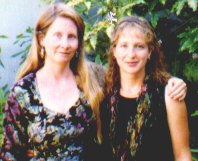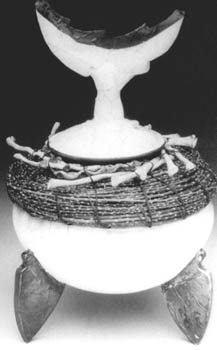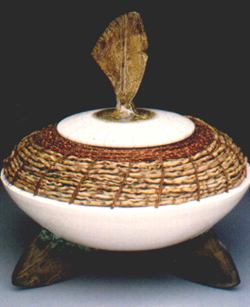BAFA © 2010. All material here is copyrighted. See conditions above. |
Chris Clay
ceramics, U.S.A.
|

Chris Clay (left)
and Suzette Nyokka.
| I love working with clay. The desire I have to work with clay came to me
while attending a Native American sweat lodge in New Mexico, in 1986
run by Felipe Ortiz. In the sweat, I sat next to the water container.
It was
beautiful, with a perfectly round mouth. Its curved body had a
luminous,
golden sheen. The longer I sat next to it, the more its beauty
captivated me.
After the sweat, I found out that Felipe made it. Not only that, but I
also learned he
taught free pottery classes at the Museum of Indian Arts in
Santa Fe, which he invited me to attend! In that class, I learned how
to coil and shape, sand and burnish pots made of the golden colored
clay containing mica (which gives the clay heat conducting properties,
making it useful for cooking). Much to my delight, I discovered that
as I worked on these pots their form, texture and design would come
right out of my hands' intuitive certainty. I learned to follow
Felipe's instructions exactly, to be thankful and to pray before the
pit firing, which was the final test of the pots' integrity and
strength.
|
I moved to California in 1989 and formed a successful business
partnership with a friend, Suzette Nyokka. Suzette, a basketmaker,
had the idea of combining ceramics and basketry to make art pieces to
sell.
I changed to using raku as a technique because sanding and
burnishing the pottery was a time consuming business.
Raku is a low fire technique where a glazed pot is heated fairly quickly
(45 minutes) in a kiln until the glaze is molten and shiny. Then it is
taken out with long tongs, put in a hole in the ground with combustible
materials and covered so that it becomes intensely smoked in a reducing atmosphere
(where there isn't much oxygen) for 20-30 minutes. The moment of truth comes
when the lid comes off of the hole and the pot is revealed. There are
interesting crackles, iridescent metallic shines, deep rich black surfaces and other effects
from the smoking that are wonderful to behold. Either that, or the pot has blown up or is
a crackle-less, or a dull gray nothing. That is the beauty and the frustration of raku
pottery.
In the beginning, Suzette and I sat down and sketched out designs
together. I would also give her pottery that had come through my
experimentation.
I loved these early collaborative pieces, so innocent and freely made.
They were not technically excellent but they had a special spirit
about them.
|
 Splendor and Beauty [Esplendor y belleza], cerámica de Chris Clay, labor de cestería de Suzette Nyokka.
Splendor and Beauty [Esplendor y belleza], cerámica de Chris Clay, labor de cestería de Suzette Nyokka.
|
 I had a bowl that I refused to give up on even though it was a little lopsided. I
cut an undulating edge around the top so that no one could notice the uneveness of the pot ,
put holes in for the attachment of the basketry and fired it up. This became a very popular
item that we called The Aurora. The first legged piece we made was featured on the front of
the prestigious American Craft Association's Baltimore whole sale show brochure. Because
of the ever changing nature of the raku technique, it can be tricky duplicating pieces.
Once I had a series of orders for just such a lidded piece that I had to
cancel because I couldn't duplicate the unusual separation of the colorants and the
glaze that had occurred. Much as I tried,
I couldn't duplicate
it again. As I have become more production oriented, this free form
experimentation has given way to more thoughtful planning. I had a bowl that I refused to give up on even though it was a little lopsided. I
cut an undulating edge around the top so that no one could notice the uneveness of the pot ,
put holes in for the attachment of the basketry and fired it up. This became a very popular
item that we called The Aurora. The first legged piece we made was featured on the front of
the prestigious American Craft Association's Baltimore whole sale show brochure. Because
of the ever changing nature of the raku technique, it can be tricky duplicating pieces.
Once I had a series of orders for just such a lidded piece that I had to
cancel because I couldn't duplicate the unusual separation of the colorants and the
glaze that had occurred. Much as I tried,
I couldn't duplicate
it again. As I have become more production oriented, this free form
experimentation has given way to more thoughtful planning.
|

|
I am inspired by Nature and her exquisite completeness. I feel so
satisfied and delicately enlivened by the beauty of the ocean patterned colors, of the mountains´
rarified air and clouds,
of the tiny lichens so intrinsically ordered. I try to mirror the
natural beauties of
life through my glazes and my shapes.
I am inspired by the clay and the fire. The fire and the clay sometimes
reveal secrets to me.
When I am working, I feel sure that the clay is teaching me its
language. My greatest
successes come when I listen very carefully to it. I also learn from
other artists' work...
|
While it is a challenge to have an art business: developing the
prototypes to sell, getting and filling orders, and maintaining quality and consistency,
Suzette and I have
been able to create art pieces that are more than they would have
been, had we been working on our own. Collaboration has had its
problems: time factors, the travelling distance (we live 4 hours
apart), individual use of the designs we worked on together and
changing artistic directions. So, the really successful part of our
business has been that we have remained best friends!
...I work
with Bahá´í youth workshops sometimes, though the youths
enthusiasm for the projects seems to ebb
and flow. I did a fireside where everyone from 3 to 96 created candle
holders out of clay.
We then put candles in the wet candle holders and everyone lit them,
honoring the light of God in our lives and hearts.
The process of creation is important to me because my spirit craves to
find expression and to
feel the presence of the Unknowable One guiding my hands and my ideas.
When one door in
my life has been closed to me, the act of creation has opened others.
It helps me to continuously
renew my hope and love for this life. When tragedy brings me to my
knees, creating has helped
me to come to terms with it.
|
I do not consider myself an artist in the
traditional sense of the word.
I don't tell people I am an artist. I try to convey to others the truth
that everyone needs to enjoy
artistic (and musical) expression, in varying forms of competency, so
that they
can expand their perceptions, enjoy life and have new horizons to
behold. This is one of the reasons
I think the arts are so important in the Bahá´í Faith. Anyway, I have
yet to meet someone who
didn't enjoy the process of creating, once they get past their
inhibitions about it! Especially working with clay.
Excerpts from Arts Dialogue, March 1999, pages 7 - 8.
Contact Chris Clay at: iet(at)sonic.net
242 Pitt Ave, Sebastopol, Calilfornia 95472 USA
- Illustration: Cell of Akka, Arts Dialogue, June 1999
- Artist Profile: Arts Dialogue, March 1999
- Illustration: Ceramic, Arts Dialogue, June 1995
|

The Cell of Akka,
ceramic by Chris Clay,
basketry by Suzette Nyokka, U.S.A.
|

Arts Dialogue, Dintel 20, NL 7333 MC, Apeldoorn, The Netherlands
email: bafa@bahai-library.com
|
|

 Splendor and Beauty [Esplendor y belleza], cerámica de Chris Clay, labor de cestería de Suzette Nyokka.
Splendor and Beauty [Esplendor y belleza], cerámica de Chris Clay, labor de cestería de Suzette Nyokka. 

 I had a bowl that I refused to give up on even though it was a little lopsided. I
cut an undulating edge around the top so that no one could notice the uneveness of the pot ,
put holes in for the attachment of the basketry and fired it up. This became a very popular
item that we called The Aurora. The first legged piece we made was featured on the front of
the prestigious American Craft Association's Baltimore whole sale show brochure. Because
of the ever changing nature of the raku technique, it can be tricky duplicating pieces.
Once I had a series of orders for just such a lidded piece that I had to
cancel because I couldn't duplicate the unusual separation of the colorants and the
glaze that had occurred. Much as I tried,
I couldn't duplicate
it again. As I have become more production oriented, this free form
experimentation has given way to more thoughtful planning.
I had a bowl that I refused to give up on even though it was a little lopsided. I
cut an undulating edge around the top so that no one could notice the uneveness of the pot ,
put holes in for the attachment of the basketry and fired it up. This became a very popular
item that we called The Aurora. The first legged piece we made was featured on the front of
the prestigious American Craft Association's Baltimore whole sale show brochure. Because
of the ever changing nature of the raku technique, it can be tricky duplicating pieces.
Once I had a series of orders for just such a lidded piece that I had to
cancel because I couldn't duplicate the unusual separation of the colorants and the
glaze that had occurred. Much as I tried,
I couldn't duplicate
it again. As I have become more production oriented, this free form
experimentation has given way to more thoughtful planning.